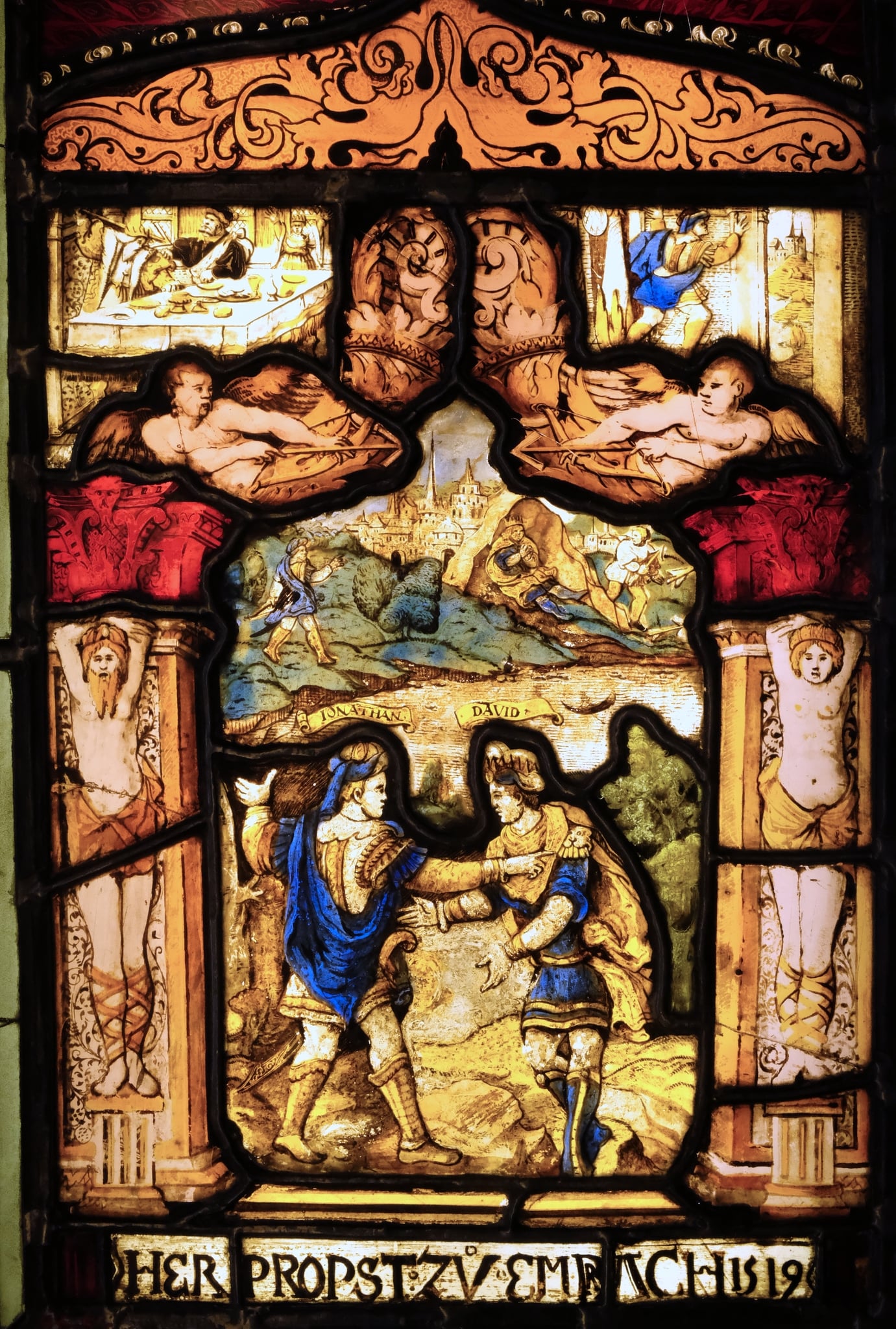The inscription naming the provost of Embrach is a stopgap. In 1519, it was Heinrich Brennwald (1478–1551) who was the provost of the collegiate church St. Peter of Embrach in Zurich (Wiggenhauser, 2005).
The central panel depicts the union of David and Jonathan who are named by inscriptions (1 Samuel 18–20). The feigned target practice was a dramatic ruse to carry on a secret communication between Jonathan and David. Through this exchange David is warned of Saul’s intentions, by which Jonathan and David further confirm their bond (1 Samuel 20: 42). The narrative of the attempt is in two parts. To the left Saul is at table and aiming his spear to the right. On the right, David flees. The male and female caryatids supporting the arch, unusually prominent, may also be interpreted as demonstrating an essential union of two individuals.
The story of Jonathan, the son of King Saul, and David is one of the more poignant elements of the sacred texts of Israel’s history. The bond of friendship is presented as immediate and enduring: “And it came to pass, when he had made an end of speaking to Saul, the soul of Jonathan was knit with the soul of David, and Jonathan loved him as his own soul (1 Samuel 18:1). Both Saul and Jonathan are killed in battle by the Philistines (1 Samuel 31:1–6). When informed of the news, David expressed a long lament that includes the verse: “I grieve for thee, my brother Jonathan: exceeding beautiful, and amiable to me above the love of women. As the mother loveth her only son, so did I love thee” (2 Samuel 1:26).
David is often represented with subjects such as of his fight with Goliath, lust for Bathsheba, or simply his representation with the harp, referencing his reputed authorship of the Psalms. The impetus for the representation of David and Jonathan apparently comes from the desire to show a special bond between two men. In a panel of 1659 showing David and Jonathan with the Arms of Albrecht Meyer (Harvard University, Fine Arts Museums 1930.480; Caviness, 1985, p. 56), the inscription reads, “Saul’s son, the holy Jonathan entered into a bond with David. He loved David with all his heart as if he were his true brother. 1 Book of Kings 20). The dedication explains that the panel commemorates Albrecht Meyer of Lenzburg, Johanna Hussler, his wife, and Rudolf Meyer, Albrech’s deceased brother. Similarly, David and Jonathan with the Arms of Johannes Cramer, 1672 (Historisches Museum Thurgau; TG_283) was a pendant to another panel given by a male donor. The inscription reads: “Saul’s son, the holy Jonathan entered into a bond with David. Each loved the other without jest, as if they possessed each other’s heart.” Sadly, with the loss of the Walter’s dedication panel, however, the donors are unidentifiable.
Jonathan’s bond with David, had enjoyed a long tradition as a model of friendship extending from the Middle Ages. La Somme le roy, a moral compendium compiled for King Philip III of France was illustrated about 1290–1300. A full-page illumination contrasted the values of friendship and hatred. David and Johnathan embracing is juxtaposed with an image of Saul attempting to kill David (London, The British Library, Add.28162 fol. 6v).
Cited in:
Hayward, Kummer-Rothenhäusler, & Raguin, 1987, p. 62.
Hayward, Kummer-Rothenhäusler, & Raguin, 1989, p. 310.
